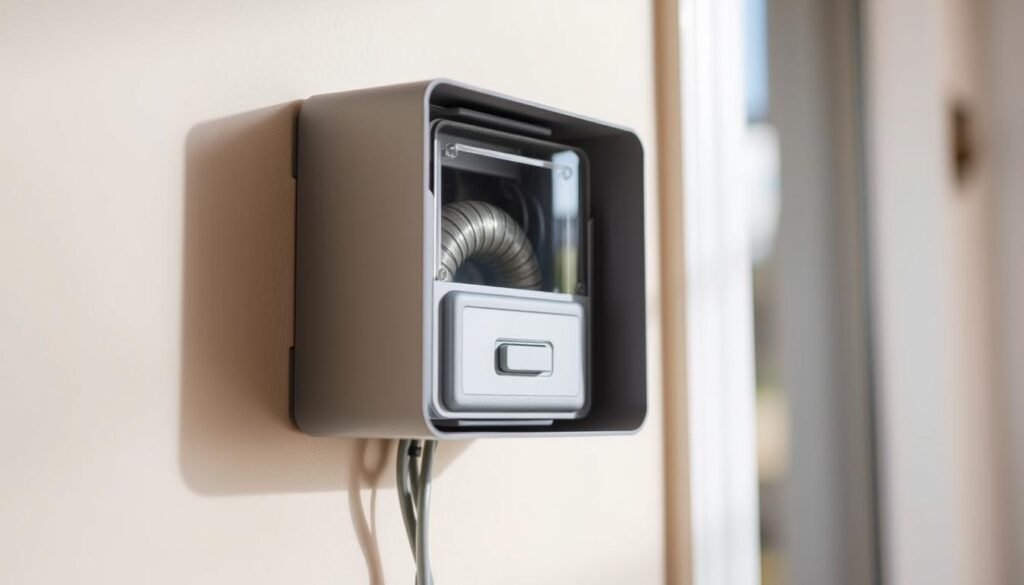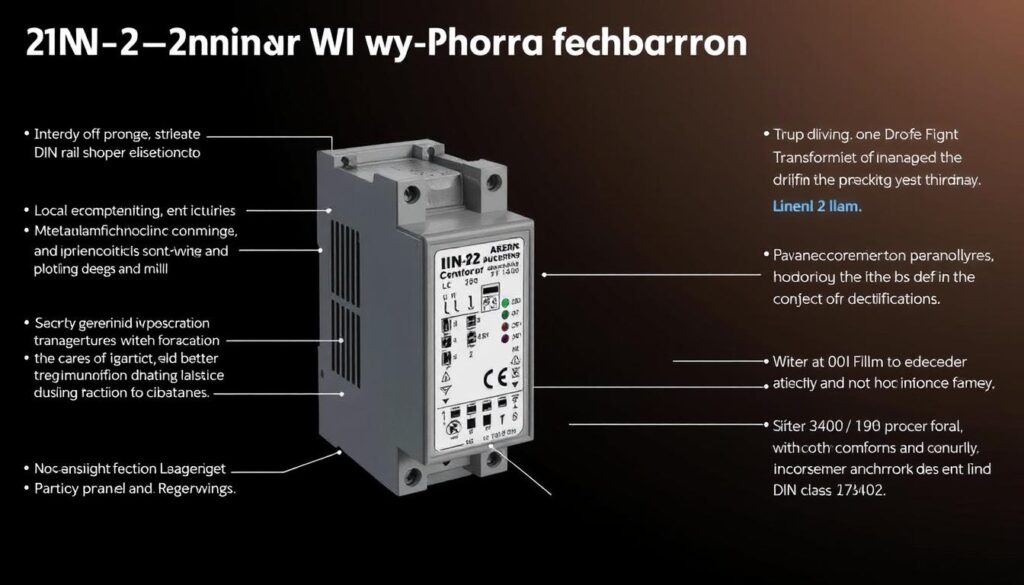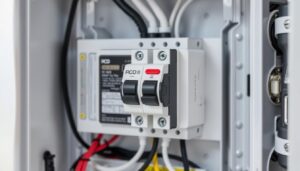Your doorbell system relies on a crucial component: the transformer. This device converts your home’s standard voltage to a lower, safer voltage suitable for doorbell operation. Understanding how your wire doorbell chime transformer works is essential for troubleshooting issues and performing maintenance or replacements when necessary.
The transformer is typically located near your home’s electrical panel or attached to a junction box. Most UK homes use transformers that convert 240V mains power to a lower voltage, usually between 8-24V, required for safe operation. Proper maintenance of your doorbell transformer ensures reliable operation and extends the lifespan of your entire doorbell system.
Key Takeaways
- Your doorbell transformer converts high voltage to a lower, safer voltage.
- Understanding your transformer’s function is crucial for troubleshooting.
- The transformer is usually located near the electrical panel or junction box.
- Most UK homes use transformers that convert 240V to 8-24V.
- Proper maintenance ensures reliable operation and extends the system’s lifespan.
What Is a Doorbell Chime Transformer and How Does It Work?
The doorbell chime transformer is a small but vital device that enables your doorbell to operate safely and effectively. It plays a crucial role in reducing your home’s 240V mains voltage to a lower, safer voltage required by doorbell systems, typically between 8V and 24V.

The Function of Wire Doorbell Chime Transformers
A doorbell transformer works through electromagnetic induction, using primary and secondary coils to step down the voltage to a level appropriate for doorbell operation. When someone presses your doorbell button, it completes a low-voltage circuit that activates the chime mechanism, producing the familiar doorbell sound. The transformer ensures that the voltage supplied to your doorbell system is compatible with its requirements, preventing damage or malfunction.
Types of Doorbell Transformers Available in the UK
In UK homes, you can typically find either surface-mounted transformers attached to junction boxes or plug-in transformers that connect directly to a power outlet. Standard transformers are designed for traditional mechanical chimes, while digital chimes and video doorbells often require specific transformer types with stable output. The voltage rating of your transformer must match your doorbell system’s requirements. Modern smart doorbell systems often require transformers with higher voltage and amperage ratings than traditional mechanical doorbell systems. Transformers for UK doorbells typically provide either 8V, 12V, 16V, or 24V output, depending on your specific doorbell model.
Using the right transformer is crucial for the proper functioning of your doorbell system. It’s essential to choose a transformer that matches your doorbell’s voltage and power requirements to ensure safe and reliable operation.
Diagnosing Common Wire Doorbell Chime Transformer Issues
Diagnosing issues with your wire doorbell chime transformer is crucial for resolving doorbell problems. A faulty transformer can lead to a range of issues, from a doorbell that doesn’t ring to one that rings faintly or makes buzzing sounds.
Signs Your Doorbell Transformer Is Failing
Common signs of a failing doorbell transformer include:
- A doorbell that doesn’t ring or rings faintly
- Making buzzing sounds or working intermittently
- Chimes that stick or don’t complete their ringing cycle properly
These symptoms indicate that your transformer might be malfunctioning.
Testing Your Doorbell Transformer
To test your doorbell transformer, you’ll need a multimeter to measure the output voltage across the transformer’s secondary terminals. A properly functioning transformer should produce a reading close to its rated voltage, typically between 8-24V depending on the model.

Voltage Requirements and Safety Considerations
Voltage requirements vary by doorbell type. Traditional mechanical chimes typically need 8-16V, while digital chimes and video doorbells often require 16-24V. Always turn off power at the fuse box or consumer unit before inspecting or touching any wiring to ensure safety.
Most UK doorbell systems use colour-coded wires (often white and green) to help identify connections during troubleshooting. Check both the transformer and the doorbell button, as either component could be the source of the problem.
How to Replace a Wire Doorbell Chime Transformer
Replacing your wire doorbell chime transformer is a straightforward process that requires some basic tools and a bit of technical know-how. Before you start, it’s essential to understand the importance of using the correct replacement parts and following safety guidelines.
Tools and Materials Needed
To replace your doorbell transformer, you’ll need a few basic tools: lineman’s pliers, a non-contact voltage tester, a screwdriver, and wire strippers. You’ll also need to purchase a replacement transformer that matches your doorbell system’s voltage requirements.
Using the correct voltage is crucial to avoid damaging your doorbell system. Make sure to check your existing transformer’s specifications before buying a replacement.
Step-by-Step Replacement Guide
Turning Off Power
Start by turning off the power to your doorbell system at the consumer unit or fuse box. Verify that the power is off using a non-contact voltage tester to ensure your safety while working on the transformer.
Removing the Old Transformer
Carefully remove the old transformer, taking note of the wiring connections. Labeling the wires will make it easier to reconnect them to the new transformer correctly.
Installing the New Transformer
Install the new transformer, ensuring that all wiring connections are secure and correctly matched to the labeled wires from the old transformer.
Testing the Installation
Once the new transformer is installed, turn the power back on and test your doorbell system to ensure it’s working correctly.
DIN Rail Transformers for Video Doorbells
For modern video doorbells, particularly those from Ring, a DIN Rail transformer can provide a consistent power supply. The Ring DIN Rail Transformer (2nd Generation) is designed specifically for Ring devices and allows for hardwiring to your mains circuit using existing doorbell wiring.

It’s essential to note that DIN Rail transformers are not compatible with mechanical or digital chimes, and professional installation by a qualified electrician is recommended to ensure compliance with UK electrical regulations.
Conclusion: Ensuring Long-Term Doorbell System Reliability
Having explored the world of wire doorbell chime transformers, it’s essential to consider the bigger picture of doorbell system maintenance. A well-maintained doorbell system not only ensures reliability but also enhances home security.
Regular maintenance of your doorbell transformer and wiring system is crucial. This includes checking for signs of corrosion, loose screws, or heat damage. When installing new doorbell devices, particularly video doorbells, consider upgrading your transformer to meet the higher power requirements.
It’s also vital to keep documentation and labels for your doorbell system, including transformer specifications and wiring diagrams. This simplifies future troubleshooting or upgrades. For homes with multiple entrances, ensure each doorbell has appropriate power from either individual transformers or a single transformer with sufficient output capacity.
By following these guidelines and consulting professional electricians when needed, you can enjoy a reliable and secure doorbell system for years to come.



